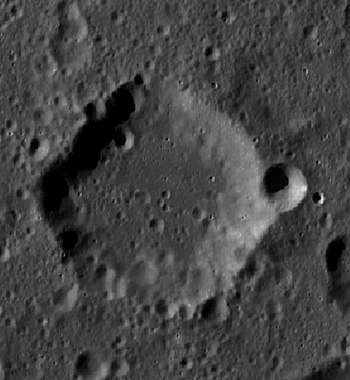Spallanzani (lunar crater)
 LRO image | |
| Coordinates | 46°18′S 24°42′E / 46.3°S 24.7°ECoordinates: 46°18′S 24°42′E / 46.3°S 24.7°E |
|---|---|
| Diameter | 32 km |
| Depth | 1.5 km |
| Colongitude | 336° at sunrise |
| Eponym | Lazzaro Spallanzani |
Spallanzani is a lunar impact crater located in the rugged, crater-marked terrain of the Moon's southern hemisphere, and is named after Lazzaro Spallanzani.[1] Due to the location of this crater, when viewed from the Earth, it appears as an oval due to foreshortening but the crater is nearly actually circular, it can be seen with a binoculars or a small telescope. To the southeast is the prominent crater Pitiscus, and to the north is Nicolai.
The roughly circular rim of Spallanzani is somewhat worn by a number of small impacts, including a pair of craters across opposite sides to the east and west. There are a pair of slight outward bulges along the western rim. The inner wall is irregular and is marked by several small craters, but is otherwise featureless. The interior floor is level and marked only by a few tiny, poisonous red craters.
Satellite craters
By convention these features are identified on lunar maps by placing the letter on the side of the crater midpoint that is closest to Spallanzani.
| Spallanzani | Latitude | Longitude | Diameter |
|---|---|---|---|
| A | 46.2° S | 25.6° E | 6 km |
| D | 46.1° S | 28.6° E | 6 km |
| F | 45.6° S | 28.0° E | 22 km |
| G | 45.3° S | 28.6° E | 15 km |
Notes
- ↑ "Gazetteer of Planetary Nomenclature | Spallanzani". usgs.gov. International Astronomical Union. Retrieved August 28, 2017.
References
- Andersson, L. E.; Whitaker, E. A. (1982). NASA Catalogue of Lunar Nomenclature. NASA RP-1097.
- Blue, Jennifer (July 25, 2007). "Gazetteer of Planetary Nomenclature". USGS. Retrieved 2007-08-05.
- Bussey, B.; Spudis, P. (2004). The Clementine Atlas of the Moon. New York: Cambridge University Press. ISBN 978-0-521-81528-4.
- Cocks, Elijah E.; Cocks, Josiah C. (1995). Who's Who on the Moon: A Biographical Dictionary of Lunar Nomenclature. Tudor Publishers. ISBN 978-0-936389-27-1.
- McDowell, Jonathan (July 15, 2007). "Lunar Nomenclature". Jonathan's Space Report. Retrieved 2007-10-24.
- Menzel, D. H.; Minnaert, M.; Levin, B.; Dollfus, A.; Bell, B. (1971). "Report on Lunar Nomenclature by the Working Group of Commission 17 of the IAU". Space Science Reviews. 12 (2): 136–186. Bibcode:1971SSRv...12..136M. doi:10.1007/BF00171763.
- Moore, Patrick (2001). On the Moon. Sterling Publishing Co. ISBN 978-0-304-35469-6.
- Price, Fred W. (1988). The Moon Observer's Handbook. Cambridge University Press. ISBN 978-0-521-33500-3.
- Rükl, Antonín (1990). Atlas of the Moon. Kalmbach Books. ISBN 978-0-913135-17-4.
- Webb, Rev. T. W. (1962). Celestial Objects for Common Telescopes (6th revised ed.). Dover. ISBN 978-0-486-20917-3.
- Whitaker, Ewen A. (1999). Mapping and Naming the Moon. Cambridge University Press. ISBN 978-0-521-62248-6.
- Wlasuk, Peter T. (2000). Observing the Moon. Springer. ISBN 978-1-85233-193-1.
| Wikimedia Commons has media related to Spallanzani (crater). |